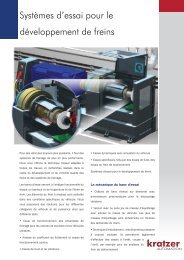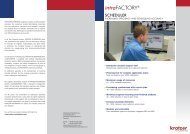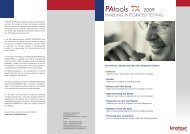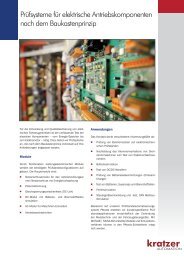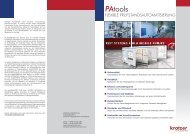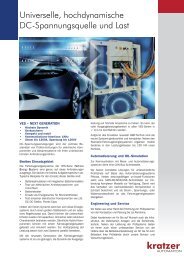TEST BENCHES FOR TURBOCHARGERS - Kratzer Automation
TEST BENCHES FOR TURBOCHARGERS - Kratzer Automation
TEST BENCHES FOR TURBOCHARGERS - Kratzer Automation
Create successful ePaper yourself
Turn your PDF publications into a flip-book with our unique Google optimized e-Paper software.
<strong>TEST</strong> <strong>BENCHES</strong> <strong>FOR</strong> <strong>TURBOCHARGERS</strong><br />
Hot gas technology<br />
This test bench is based on environmentally friendly natural gas<br />
burner technology (see illustration). The hot exhaust gas for<br />
testing the prototype is generated in a stainless steel combustion<br />
chamber and is available at a temperature of between 150<br />
and 1200°C and a pressure of from 0 to 8 bar. The mass flow<br />
is adjustable from 0.01 to 1.4 kg/s depending on the type of<br />
system (see the table on the reverse of this page).<br />
Natural gas burner technology, especially with integrated combustion,<br />
exhibits a very even temperature distribution on the<br />
turbine input and a wide adjustment range. Using this burner<br />
you can set up exactly reproducible conditions of mass flow,<br />
temperature and pressure on the turbocharger and simulate<br />
each required operating point. This means that an entire series<br />
of turbochargers can be tested on the test bench without<br />
having to make any changes to the set-up. Natural gas offers<br />
additional advantages over liquid fuels: because natural gas is<br />
supplied through a feed line there is no need for a fuel tank that<br />
would have to be periodically refilled.<br />
The test stand is constructed as a compact unit with integrated<br />
conditioning for both lubricant and coolant.<br />
Since natural gas burns with almost no pollutants – typical values<br />
are less than 100 ppm NOx and CO – there is also no need<br />
to install an exhaust gas cleaning system. In addition, the system<br />
is largely maintenance-free: we recommend just one annual<br />
inspection. The low price of natural gas compared to diesel<br />
also contributes to the generally lower running costs.<br />
General system components<br />
• Hot gas generator to provide a wide range of<br />
temperature, mass flow and pressure<br />
• Back pressure unit to adjust the correct mass flow<br />
of the TC compressor<br />
• Oil conditioning unit to adjust a stable input pressure<br />
and input temperature for the TC bearing<br />
• Water conditioning unit to adjust a stable water<br />
input temperature for water cooled bearing housings<br />
Additional equipment<br />
• Electrical heater to increase the operation field in lower<br />
temperature regions<br />
• Thermo shock unit single flow to run thermo shocks and<br />
thermo cycles<br />
• Thermo shock switching unit to run thermo shock tests<br />
with two turbochargers in parallel<br />
• Closed loop system to increase the operation field of the<br />
turbine<br />
• Exhaust gas back pressure unit to simulate the exhaust<br />
gas system<br />
• Soot contamination unit to simulate diesel application in<br />
natural gas burner<br />
• Low-pressure unit at the compressor intake to simulate<br />
compressor air-intake systems<br />
• Measuring pipes of various dimensions for measuring<br />
performance characteristics<br />
• Blow-by meter for measuring the leakage of gas from the<br />
bearing housing<br />
• Mobile oil conditioning unit for oil contamination test<br />
Testing turbochargers<br />
General tasks<br />
• Measuring characteristic maps of turbine and compressor<br />
in developing set up as well as in application set up<br />
• Stability research of thermomechanical behaviour<br />
• Endurance tests of all components, such as bearing<br />
housing, turbine wheel, etc.<br />
• Dynamic behaviour research of load capacities<br />
Specific tasks<br />
• Mapping compressor<br />
• Mapping turbine<br />
• Low temperature turbine map<br />
• Thermo shock<br />
• Temperature cycles<br />
• Blow-by tests<br />
• Low pressure test on compressor<br />
• Speed cycles<br />
• Low-cycle fatigue tests<br />
• Start stop tests<br />
• Waste gate tests<br />
• Axial trust tests<br />
• Shaft motion tests<br />
+++ COMBUSTION ENGINES +++ GEAR BOxES +++ TURBO CHARGER +++ ExHAUST PIPES +++ BRAKE SySTEMS +++ dRIVE TRAIN +++ fUEL CELLS +++ CATALyTIC CONVERTER +++ ALTERNATIVE dRIVES +++ PUMPS +++ CHASSIS +++ HyBRId



